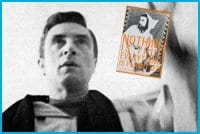About halfway into the handsome tome Nothing Is True Everything Is Permitted: The Life Of Brion Gysin, there is a passage describing how Gysin became capable of physically disappearing through the wonders of hashish and mescaline. However, one witness to his dematerialization claims that this is, “one of the least astounding stories you’ll ever hear about Brion Gysin.”
Nothing Is True is local writer John Geiger’s meticulously researched whirlwind tour of the 20th century in the guise of a bio-graphy of consummate bohemian Brion Gysin. Thanks to Geiger’s efforts, Gysin can now be known as the incredibly important and influential countercultural figure that he was. Gysin (1916 to 1986), who grew up in barren Edmonton but due to the shame of his provincial upbringing, flirted with far more cosmopolitan British, American and Swiss identities over the years, was nothing short of a career chameleon. One moment he was supping with Napoleon’s descendants (and trying on the tunic Napoleon wore at Waterloo) and the next selling off his letters from Alice B Toklas for a pittance (he famously provided the hash fudge recipe for her cookbook).
A gay painter, writer, mystic and all-around renaissance avant-gardist (he is oft compared to Rimbaud), Gysin’s life was far more colourful and frequently unbelievable than even the most imaginative fiction.
Every wild story, uncanny twist of fate, torrid love affair and epoch-defining innovation (most of which he did not get credit for) is rendered here with equal parts scholarship and dish, adding upto a fascinating tale of a dazzling mind and fiery character. He was a man of seemingly limitless ideas and imagination. Among Gysin’s many achievements were his collaborations with Beat poet William S Burroughs, specifically his discovery and development of the “cut-up” literary technique. He was also the inventor — along with Cambridge mathematics student Ian Sommerville — of the Dream Machine, a stroboscopic light device that purportedly provoked the most glorious visions and waking dreams, abstract and figurative, in the mind’s eye of those who would stand before it.
Geiger first dipped into the Gysin mythos in his smart little scientific and cultural history of such “flicker” phenomena entitled Chapel Of Extreme Experience (a 2002 release from Gutter Press). Gysin’s paintings included abstract landscapes of the sublime Sahara desert as well as widely regarded calligraphic works that, like the Dream Machine, could provoke the most elaborate visions when gazed into.
In fact, everything Gysin produced seemed to have the goal of expanding human perception and consciousness, and his artistic output soon incorporated sound poetry, performance and even film, not to mention a lifelong fascination with magic and the occult.
Gysin seems to have been everywhere: at an upright British Catholic boarding school delightfully named Downside; in the elite of the Canadian military during World War II; in Tangier with Burroughs, Paul and Jane Bowles and the Rolling Stones (he was an expert in Moroccan music, specifically the master musicians of Jajouka); in Paris’s Left Bank (he was purged from Breton’s Surrealist group as a teenager); in Harlem during its renaissance; and all points between. As famed adventuress Leila Hadley pronounced, “So many of him, so few of everyone else.”
A notoriously handsome and intimidating butch queen who was uncomfortable with his white skin, Gysin led adventures that read like an insider’s guide to seemingly every major cultural movement of the 20th century. This is brought vividly to life by Geiger’s enormous passion for his subject — 12 years of work, with every last detail footnoted and indexed. In the hands of a lesser scholar, the catalogue of artistic greats and socialites who made appearances in Gysin’s life — from Max Ernst, Gore Vidal and Felicity Mason to Genesis P-Orridge, Iggy Pop and Keith Haring — would seem like name-dropping. But Geiger’s goal is as much to illuminate the strange, enigmatic figure of Gysin as to prove beyond a doubt his centrality to cultural history.
Gysin emerges as a brilliant, difficult, hedonistic figure who was all too aware that he was destined for a “post-mortem genius career” while his friends and rivals achieved fame and fortune. His arrogant façade was a means of self-preservation. While his entire life story is gripping, the final pages detailing his many loved ones gathering to scatter his ashes off a cliff in Morocco after his years of suffering painful colon cancer treatments, never having achieved recognition nor respect by the public, have an almost unbearable poignancy.

 Why you can trust Xtra
Why you can trust Xtra


